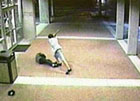 Some weeks ago I posted some thoughts on audio compression and made a mental note to follow up with a similar post regarding video. A series of attacks, including one that ended in a death, recently made the news (via Drudge Report) and brought this back to mind. The CCTV security camera images shown obviously are not HDTV (High Definition TeleVision) quality, to say the least. Surely CCTV systems are intended for such situations and one would expect to have sufficient resolution to ID (identify) the individuals in the images, right? So why are the images so poor?
Some weeks ago I posted some thoughts on audio compression and made a mental note to follow up with a similar post regarding video. A series of attacks, including one that ended in a death, recently made the news (via Drudge Report) and brought this back to mind. The CCTV security camera images shown obviously are not HDTV (High Definition TeleVision) quality, to say the least. Surely CCTV systems are intended for such situations and one would expect to have sufficient resolution to ID (identify) the individuals in the images, right? So why are the images so poor? Before I go on, let me say that the comments I am about to make are general ones using this particular case as a taking-off point instead of an example. I say this because I have not seen the originals and therefore can not say for certain that my comments will apply to this particular case. What I do know from personal experience is that in the majority of similar cases, the live video has very good resolution. It is the archived (i.e. stored) video that is obtained by detectives and examiners that is the problem. How can this be?
Before I go on, let me say that the comments I am about to make are general ones using this particular case as a taking-off point instead of an example. I say this because I have not seen the originals and therefore can not say for certain that my comments will apply to this particular case. What I do know from personal experience is that in the majority of similar cases, the live video has very good resolution. It is the archived (i.e. stored) video that is obtained by detectives and examiners that is the problem. How can this be? Well, imagine that you are a proverbial fly-on-the-wall during the procurement of a CCTV system for a company or municipality. System specifications, performance, and cost are obviously key factors in selecting the vendor and particular system configuration. Vendors 'A' and 'B' both separately present similar systems - the same numbers of cameras, warranty, help desk support, and so on. During the live demonstration, you (the fly) see crystal clear, ID-quality color pictures of people on the street and the operator can pan-tilt-zoom the cameras to follow specific individuals. "Great, I'll have one of those!", you think. But when the time comes to tally up the bill, one of the vendors inevitably bids a bit lower or, if not, the purchasing agent negotiates them down. In either case, where do you think is an easy place to make a quick cost savings? By cutting the number of cameras? Certainly not - that could mean not covering all of the area. Going with black-and-white? No again. Squeezing more out of the video storage? Now you're talking. "How can they do that?", you might ask if you could, but you can't, because you're a fly, remember? Don't they need to archive so many days' worth of images to meet the specification? Yes, but by turning the 'Wonder Knob' (i.e. the compression ratio selector) all of the sudden they can fit twice as much video into half the space and what is seen on the live monitor doesn't change a bit. Money saved - job done. Just don't go and look at the archived images. Compressing the images almost always means throwing significant information away, in the form of entire frames, picture detail, or both. How else can you fit the same number of days of storage into a smaller space?
Well, imagine that you are a proverbial fly-on-the-wall during the procurement of a CCTV system for a company or municipality. System specifications, performance, and cost are obviously key factors in selecting the vendor and particular system configuration. Vendors 'A' and 'B' both separately present similar systems - the same numbers of cameras, warranty, help desk support, and so on. During the live demonstration, you (the fly) see crystal clear, ID-quality color pictures of people on the street and the operator can pan-tilt-zoom the cameras to follow specific individuals. "Great, I'll have one of those!", you think. But when the time comes to tally up the bill, one of the vendors inevitably bids a bit lower or, if not, the purchasing agent negotiates them down. In either case, where do you think is an easy place to make a quick cost savings? By cutting the number of cameras? Certainly not - that could mean not covering all of the area. Going with black-and-white? No again. Squeezing more out of the video storage? Now you're talking. "How can they do that?", you might ask if you could, but you can't, because you're a fly, remember? Don't they need to archive so many days' worth of images to meet the specification? Yes, but by turning the 'Wonder Knob' (i.e. the compression ratio selector) all of the sudden they can fit twice as much video into half the space and what is seen on the live monitor doesn't change a bit. Money saved - job done. Just don't go and look at the archived images. Compressing the images almost always means throwing significant information away, in the form of entire frames, picture detail, or both. How else can you fit the same number of days of storage into a smaller space?Time passes. The system is installed and everything seems to be going along just fine until a crime occurs and the police show up to recover the video. Then, lo and behold, the archived video looks no where near as good as it did when it was live. Now the police have a distant, slightly fuzzy image of a probable male suspect in poor lighting. Then when they zoom in for a close-up, the face becomes pixelated and nearly unuseable. That sinking feeling they experience can't be very pleasant, even when it was mostly expected...
Seems a bit shameful after all that money spent on the CCTV system, doesn't it?
If any CCTV system managers or operators are reading this, please go turn the 'Wonder Knob' back down. The police will thank you and so will the public. On top of that, you will probably save yourself an unpleasant question-and-answer session with your supervisor when an event does eventually occur.
(image source: Ft. Lauderdale Police Department, Florida, USA)

1 comment:
yes... this cctv is best security product... cctv finding crime.... and terrorism
roshid
cctv chennai
Post a Comment